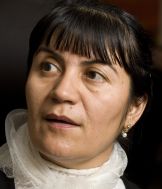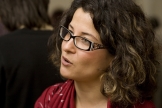Stepping into this totally new area of poetry was daunting. I was aware of the complexity and richness of the tradition Farzaneh writes in but my knowledge of it was limited. Narguess was the ideal guide, teacher and interpreter for this journey. Our meeetings took place in the Common Room at SOAS, Narguess’s workplace and only a short stroll for me from my teaching base at Royal Holloway’s building in Bedford Squatre. At our first meeting Narguess gave me a selection of her literal translations of Farzaneh’s poems, complete with informative notes, line by line. They were already a graceful read and it was clear at once that her versions were going to be a pleasure to work with. Narguess read to me from the poems in Persian that first time, too, and most subsequent meetings. This proved to be crucial and fruitful – when I first heard Farzaneh read, I felt I had caught some of her music, which was down hearing Narguess in my head as I worked at the poems.
An interesting difficulty for Narguess, but not so much for me, was that Farzaneh’s very pure, classical Persian is written for the reader in Tajikistan, in cyrillic script, not arabic script. Narguess, from Tehran, reads Arabic script. For this reason, the poems we translated were taken from the Persian edition of Unending Sigh, published in Iran in 2007. Farzaneh felt these poems were from an older phase of her work and would, I think, have chosen a different set if she could, but the advantage for me was that the work we looked provided a broader stylistic range than her more recent, more traditionally formal poems.
Extracted from Translating Farzaneh Khojandi by Jo Shapcott
Download This Recording For Free
Subscribe to this Podcast on iTunes
Buy a short collection of Jo Shapcott’s Translations of Farzaneh Khojandi




